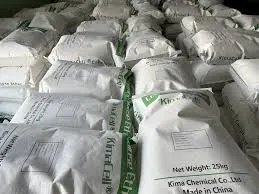
Nov . 11, 2024 14:08 Back to list
hydroxyethyl cellulose thickening mechanism
The Thickening Mechanism of Hydroxyethyl Cellulose
Hydroxyethyl cellulose (HEC) is a non-ionic, water-soluble polymer that is widely utilized in various industries, particularly in cosmetics, pharmaceuticals, and food products, due to its thickening properties. Understanding the thickening mechanism of HEC is essential for optimizing formulations, achieving desired viscosities, and enhancing product performance. This article delves into the chemical structure, solubility, thickening mechanism, and practical applications of hydroxyethyl cellulose.
Chemical Structure and Properties
Hydroxyethyl cellulose is derived from cellulose, the abundant organic polymer found in the cell walls of plants. To create HEC, cellulose is chemically modified by etherification with ethylene oxide, introducing hydroxyethyl groups into the cellulose backbone. This modification increases the solubility of cellulose in water and allows HEC to act as a thickening agent. The degree of substitution (DS) of hydroxyethyl groups can vary, impacting the solubility and rheological properties of the polymer.
HEC exhibits several important properties. It possesses a high molecular weight, which contributes to its ability to form viscous solutions. Its non-ionic nature allows it to be compatible with a wide range of ionic and non-ionic ingredients without undergoing precipitation or gelation. Additionally, HEC is stable across a broad pH range, which makes it suitable for use in diverse formulations.
Thickening Mechanism
The thickening mechanism of hydroxyethyl cellulose involves its ability to increase the viscosity of aqueous solutions through a combination of hydrodynamic and macromolecular interactions
. When HEC is dispersed in water, the polymer chains begin to hydrate and swell. This swelling arises from the hydrophilic hydroxyl groups that interact with water molecules, creating a viscous gel-like structure.One of the key mechanisms by which HEC increases viscosity is through entanglement. As the polymer chains swell, they begin to intermesh with one another, forming a network that resists flow. This entangled structure creates a physical barrier, requiring greater force to move the liquid, thus increasing viscosity. Furthermore, the hydrodynamic volume of the polymer coils also contributes to the resistance to flow, as larger polymer structures possess higher drag.
Another important factor in the thickening mechanism is the hydrogen bonding between the hydroxyl groups on the HEC and water molecules. This interaction not only helps stabilize the polymer in solution but also increases the overall viscosity by creating a structured environment around the polymer chains. As the concentration of HEC increases, there are more chain interactions, leading to further viscosity enhancement.
hydroxyethyl cellulose thickening mechanism

Temperature and Shear Rate Effects
The thickening efficiency of HEC can also be influenced by temperature and shear rate. Typically, increasing the temperature can reduce viscosity, as the kinetic energy of the molecules increases, making it easier for the chains to disentangle. However, HEC is known to maintain its performance over a range of temperatures, making it versatile for various formulations.
Shear rate plays a significant role in the behavior of HEC solutions. Under low shear conditions, HEC solutions exhibit pseudoplastic behavior, meaning they can flow easily. However, under high shear conditions, such as during mixing or pumping, the viscosity may decrease temporarily. Once the shear forces are removed, the viscosity of the solution rebounds, demonstrating the non-Newtonian characteristics of HEC.
Applications in Various Industries
HEC is utilized in a wide array of applications due to its thickening properties. In the cosmetic industry, it serves as a stabilizing agent in lotions, creams, and gels, providing a desirable texture and enhancing product stability. In pharmaceuticals, HEC is used in drug formulations to control release rates and improve the bioavailability of active ingredients.
In the food industry, HEC acts as a thickener and stabilizer in sauces, dressings, and other prepared foods. Its ability to enhance mouthfeel and texture is invaluable in producing consumer-friendly food products.
Conclusion
Hydroxyethyl cellulose is a versatile thickening agent that plays a crucial role in numerous applications across various industries. Its thickening mechanism, driven by polymer entanglement and hydrodynamic interactions, allows it to improve viscosity effectively. Understanding the properties and behavior of HEC enables manufacturers to optimize formulations, offering high-quality products that meet consumer demands. As research continues, HEC remains an essential component in the development of innovative solutions in the field of material science.
-
Versatile Hpmc Uses in Different Industries
NewsJun.19,2025
-
Redispersible Powder's Role in Enhancing Durability of Construction Products
NewsJun.19,2025
-
Hydroxyethyl Cellulose Applications Driving Green Industrial Processes
NewsJun.19,2025
-
Exploring Different Redispersible Polymer Powder
NewsJun.19,2025
-
Choosing the Right Mortar Bonding Agent
NewsJun.19,2025
-
Applications and Significance of China Hpmc in Modern Industries
NewsJun.19,2025







